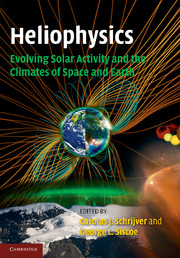Book contents
- Frontmatter
- Contents
- Preface
- 1 Interconnectedness in heliophysics
- 2 Long-term evolution of magnetic activity of Sun-like stars
- 3 Formation and early evolution of stars and protoplanetary disks
- 4 Planetary habitability on astronomical time scales
- 5 Solar internal flows and dynamo action
- 6 Modeling solar and stellar dynamos
- 7 Planetary fields and dynamos
- 8 The structure and evolution of the three-dimensional solar wind
- 9 The heliosphere and cosmic rays
- 10 Solar spectral irradiance: measurements and models
- 11 Astrophysical influences on planetary climate systems
- 12 Assessing the Sun–climate relationship in paleoclimate records
- 13 Terrestrial ionospheres
- 14 Long-term evolution of the geospace climate
- 15 Waves and transport processes in atmospheres and oceans
- 16 Solar variability, climate, and atmospheric photochemistry
- Appendix I Authors and editors
- List of illustrations
- List of tables
- References
- Index
- Plates
8 - The structure and evolution of the three-dimensional solar wind
Published online by Cambridge University Press: 05 April 2013
- Frontmatter
- Contents
- Preface
- 1 Interconnectedness in heliophysics
- 2 Long-term evolution of magnetic activity of Sun-like stars
- 3 Formation and early evolution of stars and protoplanetary disks
- 4 Planetary habitability on astronomical time scales
- 5 Solar internal flows and dynamo action
- 6 Modeling solar and stellar dynamos
- 7 Planetary fields and dynamos
- 8 The structure and evolution of the three-dimensional solar wind
- 9 The heliosphere and cosmic rays
- 10 Solar spectral irradiance: measurements and models
- 11 Astrophysical influences on planetary climate systems
- 12 Assessing the Sun–climate relationship in paleoclimate records
- 13 Terrestrial ionospheres
- 14 Long-term evolution of the geospace climate
- 15 Waves and transport processes in atmospheres and oceans
- 16 Solar variability, climate, and atmospheric photochemistry
- Appendix I Authors and editors
- List of illustrations
- List of tables
- References
- Index
- Plates
Summary
Introduction
Parker (1958) showed that the natural state of a hot and extended stellar corona is one of supersonic, super-Alfvénic expansion. In the case of the Sun, the evolution of the strong magnetic field that permeates the corona modulates this expansion (e.g. Pneuman and Kopp, 1971). Indeed, it is the interplay between the coronal magnetic field and the expansion that produces both a highly structured solar corona and a spatially variable solar wind (see Vol. I, Chapter 9). For example, the combed-out appearance of the outer solar corona is a product of the coronal expansion. Because the solar wind plasma is an excellent electrical conductor, the coronal magnetic field is “frozen” into the solar wind flow (Vol. I, Chapter 3) as it expands away from the Sun, forming what is now commonly called the heliospheric magnetic field, HMF. A simple model of the HMF (Parker, 1958) predicts that solar rotation causes the HMF in the solar equatorial plane to be bent into Archimedean spirals (Vol. I, Section 9.2) whose inclinations relative to the radial direction depend on heliocentric distance and the speed of the wind.
The Sun's magnetic field evolves continually, the most pronounced changes being those associated with the advance of the ˜11-year solar activity (sunspot) cycle and the ˜22-year magnetic cycle.
- Type
- Chapter
- Information
- Publisher: Cambridge University PressPrint publication year: 2010
- 1
- Cited by



